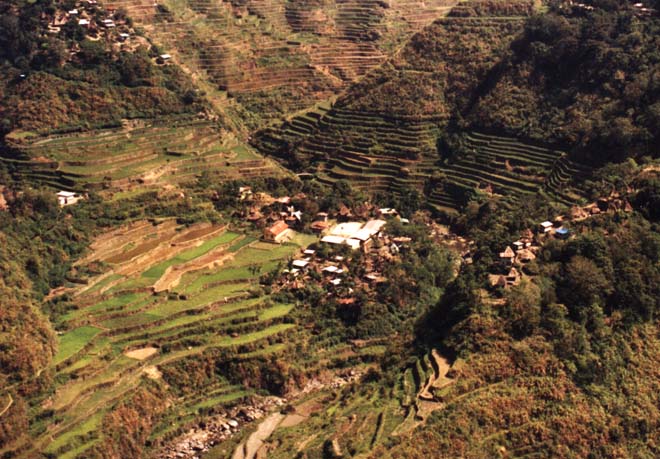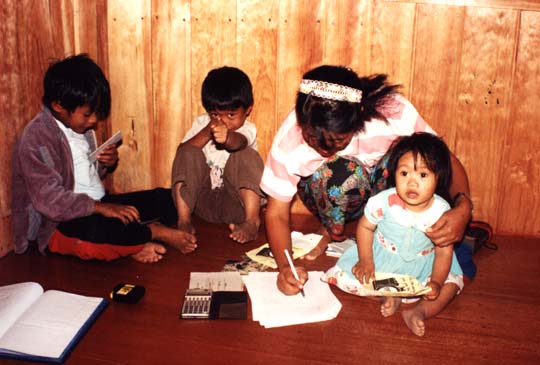
| 3 | Local conditions | previous |
| 3.1 | Availability of year-round water | index page |
An obvious condition for a firefly system to work is the availability of a suitable water source. Still this is a difficult thing to judge, important aspects are:
The above points are limited to physical conditions, as if one could just select the most advantageous site from a technical point of view and then start digging and building. But there are people living there who all have their ideas, plans and rights:
All above points refer to specific potential sites. When looking at a certain area, a fifth point comes into view:
These points will be discussed more in detail in annex J: Selecting a site. A thing that comes back with all points is, that asking information from local people could be much better than trying to figure things out by oneself. Especially if local farmers irrigate their crops, they will know quite a lot about water sources in their area. So when it comes to choosing sites, it is probably best to try to explain (or demonstrate) how the firefly system works and leave it to local people to select a site.
The fifth point is especially relevant here:
This issue should be decided upon in a very early stage and therefor one can not expect much useful information from local people as they will hardly understand what the firefly system is about until they have seen one running.
 |
Fig. 3.1: Cambulo, the pilot village of PRRM's Micro Hydro project. To irrigate the rice terraces, there are small irrigation canals and one of them was used for the charger. |
Some brief guidelines are:
The guidelines above emphasise the availability of water. But the charger also needs a certain head (= water pressure), so the terrain should be so hilly that sites with enough head can be found. Usually finding such sites is not such a problem because:
See fig. 2.1 for an illustration of typical layout of a firefly charger.
| 3.2 | Need for electric light |
Some general thoughts on whether there could be a need for electric light:
Clearly it makes no sense to introduce the firefly in an area where people don't want or don't need electric light. This speaks for a rather passive approach: Only if local people ask for better light, solar systems or Micro Hydro power, one could start thinking about introducing the firefly. On the other hand, people might not even think about whether or not they would like electrical light if they had never realised that electric light might be possible and affordable in their situation. This speaks for a more active approach: Starting a demonstration project and then discussing the pro's and con's of this technology with local people.
There is the risk that local people react enthousiastically to the idea of having a firefly system, but prove much less enthousiastic later on. They might like to have any project implemented in their village rather than in a neighbouring community. They might like project representatives visiting their village. But once it comes to working or paying for materials, they might expect that everything comes for free from the project. This means that one will only know whether they are really interested when they are willing to bear the costs: In labour for building the canal etc. and in money for the charger and the materials for home systems, see also par. 3.4.
 |
Fig. 3.2: Rosita Bentican signs a loan agreement. Materials for the home system were sold on installment basis. Rosita is a teacher so she needs good light at night and earns enough to afford it. |
| 3.3 | Possibilities for local production |
Here, local production means producing firefly chargers in the same province or region, but not necessarily in the communities where they will be installed. Car repair workshops could build chargers while electronics repair workshops could build switchboards and charge indicators. Such workshops will only exist along major roads or in cities.
Local production is important because:
For local production to become possible, the following conditions should be met:
Apart from workshops producing firefly chargers and charge indicators, there is a role for traders trading in batteries, cables, switches, lamps etc. Those items form the bulk of the costs of a firefly system so it is important that they are available within the area and at decent prices. Maybe traders will take the lead role in introducing firefly chargers rather than workshops building components.
| 3.4 | Social and economic aspects |
Social aspects are difficult to discuss in general. Some experiences from the Cambulo project might shed some light on these. Hopefully, this paragraph will raise the right questions and then it is up to readers themselves to find answers.
Some social aspects strongly influence the chances of the firefly being introduced succesfully, assuming that one would decide to try to introduce it.
Willingness to cooperate: The firefly can be used most economically if one charger serves a user group of about 10 families. If people would not want to cooperate or would not be able to cooperate, a user group that owns and manages a charger is out of the question, see par. 2.3.
Existing groups could form the start of a user group and in that case there is no need to try to form a user group right from the start. In Cambulo, a well-run cooperative store took up this role and I think this was the main reason why it proved possible to get the firefly introduced there in only 10 months (see par. 1.1).
If one would like to ask an existing group to serve as a starting point for a user group, the choice of such a group becomes a tricky question. Quite likely, a community is divided into different professions, different religious groups, supporters of different political parties, clans, native people and settlers who came from other areas etc. Giving one group access to the firefly technology while others don't have this, could be a reason for envy. Just discussing a possible project with one group might make other people feel being left out. Then these people might react negatively when asked to join discussions in a later phase, even though they might have liked to join in when they were asked right from the start.
There are limits as to what level people are willing to cooperate. The Cambulo users were not interested in sharing one large capacity solar battery between 2 to 4 families, even though that would have reduced both investment costs and running costs significantly. They argued that it would not be possible to measure how much electricity each family would use (and divide costs accordingly). Also they expected problems if the battery would not be taken care of properly, wear out prematurely and a replacement would have to be bought. Only within a family, people were willing to share a battery.
Attitude towards development initiatives: Of course this will be influenced by succes or failure of previous development initiatives in the area. The main question is whether people will take up responsibility for their system, or whether they will expect outside people to solve the problem once some parts are worn out or destroyed.
Attitude towards innovations: To get a new technology introduced, some people have to be the first to try it out. Those first people take risks, of losing money if the technology turns out to be a failure, but such a failure would also affect their status within the community. If general attitude towards innovations is such that no one wants to serve as `guinea pig' in trying out a new technology, this could be an obstacle in getting a user group to pilot the firefly. In Cambulo apparently it wasn't: People who weren't interested in joining themselves, still liked other ones to try. Then if it would turn out profitable, they might join in later and benefit from the experiences gained by these first people.
Attitude towards some people having things others don't have: From a western point of view, it is only normal that people who joined the project, paid the costs and took the efforts, will have electric light while others won't. But within some cultures, this might not be seen as normal at all. People who have it, might be under pressure to share it with family members or community members. From a technical point of view, it just isn't possible to light more than a few, closely spaced houses with one large battery. When battery owners refuse to share the electricity, they go against a social norm and problems might rise. The ones who have no electric light, might see this as enough reason to sabotage the project.
So this attitude will affect chances of a charger, batteries, wiring being stolen or destroyed. Of course there might be many other reasons why firefly materials are destroyed or stolen, see the criminality in our western society.
Who will claim a leading role: For a firefly user group to function properly, there should be capable people doing key tasks (operator, administration of charging fees etc.). When such people are around, it does not necessarily mean that those people will volunteer (or: be chosen) to perform those tasks. The firefly might become a status symbol and people who are powerful within the community, might claim a key role for themselves. This could seriously affect chances of succes.
In Cambulo, it seemed just logic to have at least one woman trained as operator because most of the men left the village at certain times of the year to work in the lowlands. When I suggested that a woman should be trained as operator, people just didn't react. Apparently dealing with the charger was seen as men's work. Maybe women felt less fit for such a technical task and probably they weren't that interested in learning it because they didn't like to carry heavy batteries along steep trails.
Social aspects are not only relevant as to whether or not the firefly could and should be introduced. Also social situation might change because of the firefly. For instance, people might learn to cooperate more easily to solve common problems. One succesful development activity might become the start of another initiative, and yet another. In Cambulo: Started with a coop store, then the firefly came. then my brother Ruud came and made a map of all irrigation canals.
 |
Fig. 3.3: The trail to Cambulo: A 12 km hike to the nearest road. It is unlikely that Cambulo will be connected to the national grid in the foreseeable future. |
The economic aspects are more straight-forward: Of course potential users should be able to afford the costs of the firefly system. There is no sense in introducing the firefly if one knows that even in the long run costs will have to be subsidized because potential users are just too poor. Or even worse: If users do pay full costs but at the expense of basic needs like food, housing, health care, school fees.
It is difficult to predict costs of a firefly system in general. Investment costs in money terms depend on:
Running costs in money terms depend on:
In the Philippines, investment costs were estimated at $ 150 for a charger and $ 75 for a home system (1992 prices). This means that at 10 users per charger, total investment costs would be $ 90 per user.
But there are also costs in terms of labour that depend strongly on local conditions:
Not only the costs of the firefly are relevant in this, but also costs of alternative systems, see par. 2.4. A major conclusion from this:
It makes no sense to try to introduce the firefly in an area that is connected to the national grid or will be connected in the foreseeable future.